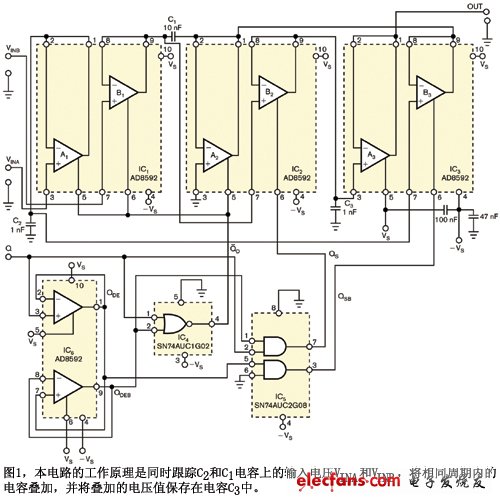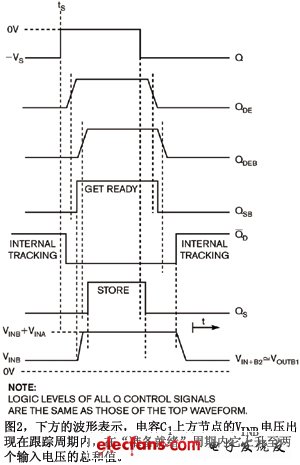Some applications require sampling of a set of analog voltages, and at least two traditional methods can meet this requirement. The most common approach is to cascade a classic analog accumulator with a sample-and-hold amplifier. The classic analog accumulator is an op amp plus at least three precision resistors. The values ​​of these resistors should be as low as possible to avoid affecting the bandwidth of the accumulator. But these low value resistors consume power. In addition, the structure of the accumulator and the sample-and-hold amplifier brings another disadvantage, which is manifested when the two input voltages have similar amplitudes and opposite polarities. At this time, even if the input voltage amplitude is high, the sum obtained is low, and if the input voltage amplitudes are equal, the sum is zero. Sampling low voltages usually results in relatively large errors in the output voltage because each amplifier has some dynamic error, such as residual parasitic charge coming into the storage capacitor.

There is also a possible way to use an amplifier per channel to summarize their outputs with a classic analog accumulator. Although this configuration avoids the problem that the input voltage amplitude is similar and the opposite polarity causes high output error, the precision resistor of the accumulator still consumes power.

These problems can be avoided by using the circuit structure of Figure 1, which does not use an external resistor. In steady state, the internal logic signal is active high during the internal tracking period, and the followers consisting of A1, B1 and A2 are enabled. Therefore, the ground referenced capacitor C2 is charged to the VINA voltage. The low side of capacitor C1 on IC2 Pin 2 is temporarily grounded through the output of the A2 follower, and it is connected to the high-end charge of IC1 Pin 9 to the VINB voltage. VINA and VINB are the input voltages for the A and B inputs, respectively.
After a stabilization period, when all internal logic control signals are low and all controlled followers are disabled, the QSB control logic signal is high. Since the follower B3 is enabled, the potential of the low side of C1 is from 0V to VC2(tS) = VINA(tS). VC2(tS) is the voltage value stored in capacitor C2, and then the signal transitions to an inactive low level. The high-end potential of C1 thus rises to VC2(tS) + VC1(tS) = VINA(tS) + VINB(tS), as shown in the lower waveform in Figure 2. This waveform is the only analog waveform in this figure. The low-to-high effective conversion of the sampling command logic signal QS slightly lags behind the QSB logic signal, suppressing glitches on the output voltage. When QS is high, the sample voltage VINA(tS) + VINB(tS) appearing on IC2 Pin 7 is accessed by enable follower B2 and stored in capacitor C3 until the next sample instruction. Follower A3 acts as an impedance transformer. The dual op amp IC6 acts as a branch delay line that combines with a single NOR gate and a dual AND gate to derive a timing-correct internal logic control signal from a single external logic control signal Q.
Digital currency transactions allow users to convert existing digital currencies into other digital currencies. The entire transaction does not involve any legal tender. Because of the relatively loose regulation, the mainstream digital currency trading platform also opened this function.Digital Asset Exchange (DAE) is a platform for matching transactions between digital currencies, digital currencies and legal currencies. It is the main place for encrypting the circulation and price determination of digital currency transactions.
Compared with traditional stock exchanges, digital asset trading platform not only matches transactions, but also plays the role of market maker and investment bank. The role of the market maker in the trading platform can increase the liquidity of the market, and the trading platform can earn the transaction price difference. The role of the investment bank of the trading platform is to provide services such as issuance and underwriting of digital currency, from which the trading platform collects money fees, or collects deposits in the form of community voting of the trading platform.
Currency Exchange,Digital Currency Exchange,Virtual Digital Currency Exchange,Display Currency Exchange
China youbi digital assets limited , https://www.ubcoinchina.com